Abstract
The potent transforming activity of membrane-targeted Raf-1 (Raf-CAAX) suggests that Ras transformation is triggered primarily by a Ras-mediated translocation of Raf-1 to the plasma membrane. However, whereas constitutively activated mutants of Ras [H-Ras(61L) and K-Ras4B(12V)] and Raf-1 (DeltaRaf-22W and Raf-CAAX) caused indistinguishable morphologic and growth (in soft agar and nude mice) transformation of NIH 3T3 fibroblasts, only mutant Ras caused morphologic transformation of RIE-1 rat intestinal cells. Furthermore, only mutant Ras-expressing RIE-1 cells formed colonies in soft agar and developed rapid and progressive tumors in nude mice. We also observed that activated Ras, but not Raf-1, caused transformation of IEC-6 rat intestinal and MCF-10A human mammary epithelial cells. Although both Ras- and DeltaRaf-22W-expressing RIE-1 cells showed elevated Raf-1 and mitogen-activated protein (MAP) kinase activities, only Ras-transformed cells produced secreted factors that promoted RIE-1 transformation. Incubation of untransformed RIE-1 cells in the presence of conditioned medium from Ras-expressing, but not DeltaRaf-22W-expressing, cells caused a rapid and stable morphologic transformation that was indistinguishable from the morphology of Ras-transformed RIE-1 cells. Thus, induction of an autocrine growth mechanism may distinguish the transforming actions of Ras and Raf. In summary, our observations demonstrate that oncogenic Ras activation of the Raf/MAP kinase pathway alone is not sufficient for full tumorigenic transformation of RIE-1 epithelial cells. Thus, Raf-independent signaling events are essential for oncogenic Ras transformation of epithelial cells, but not fibroblasts.
Full text
PDF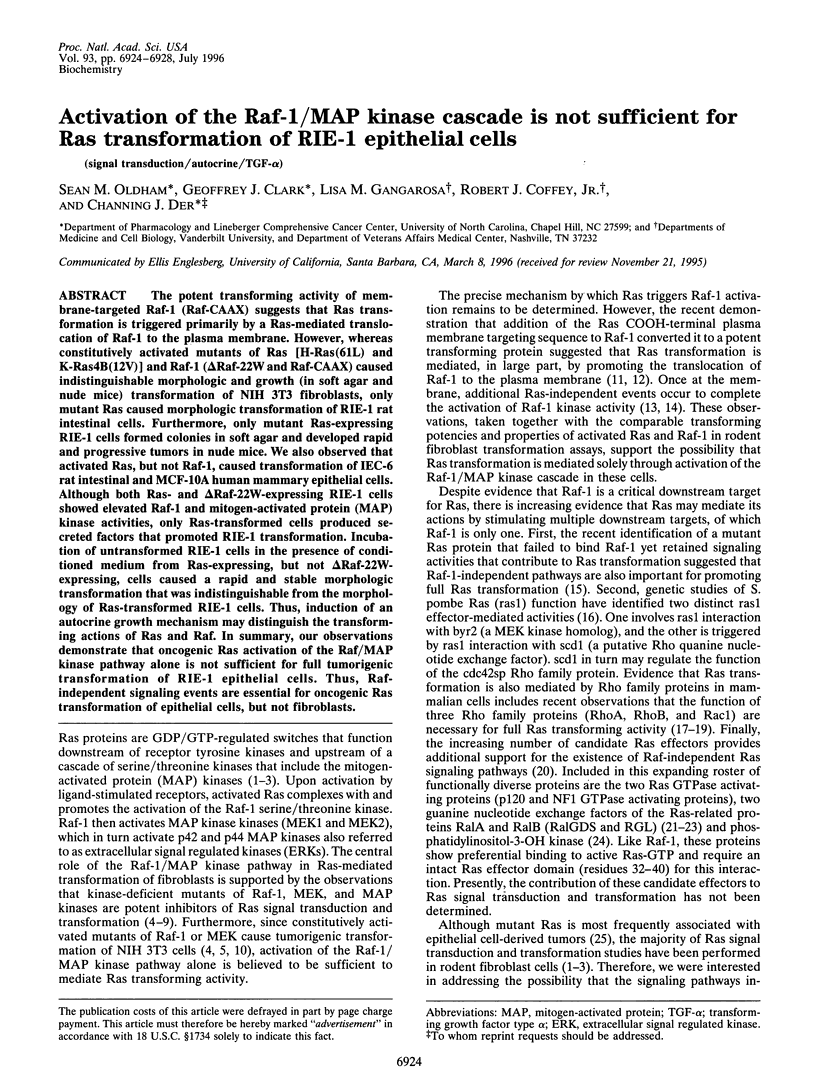
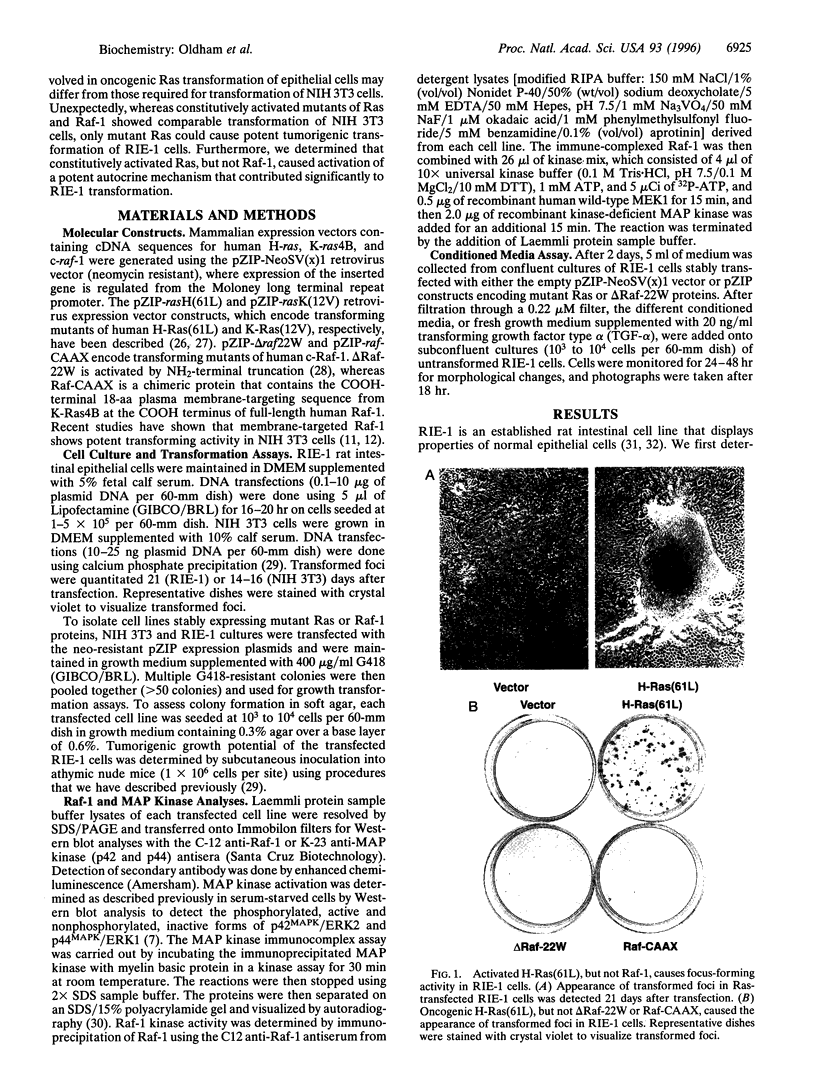
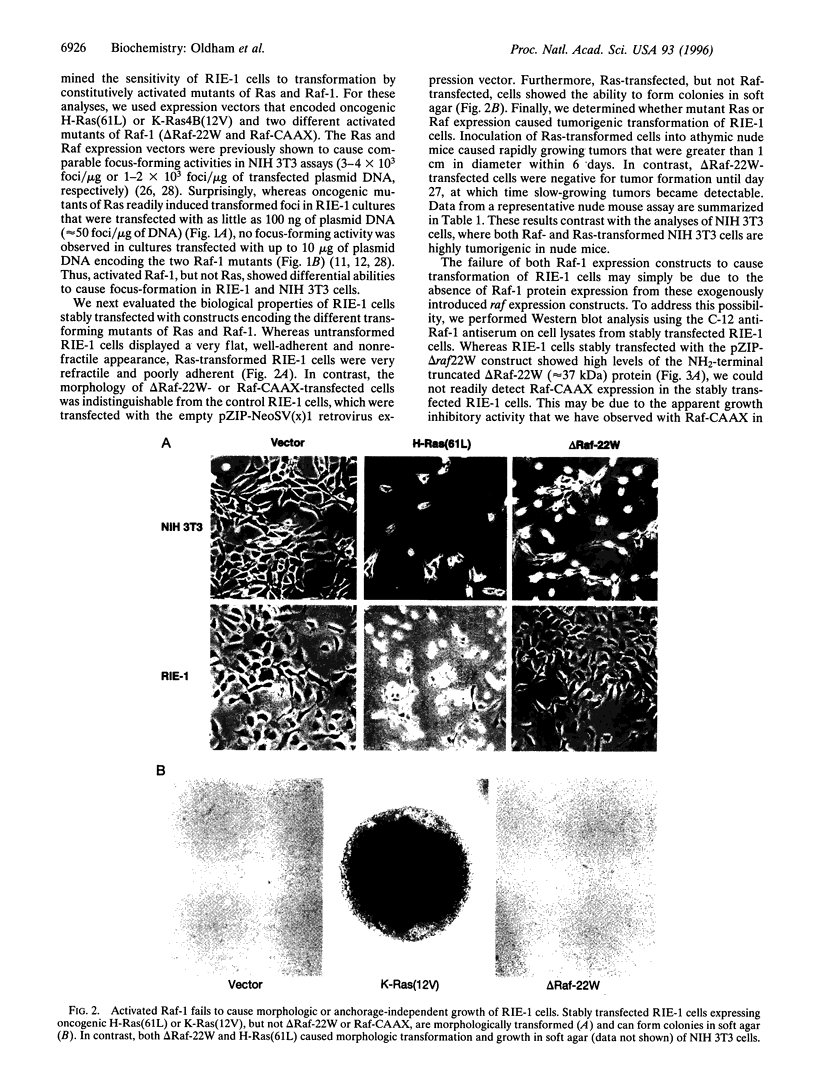
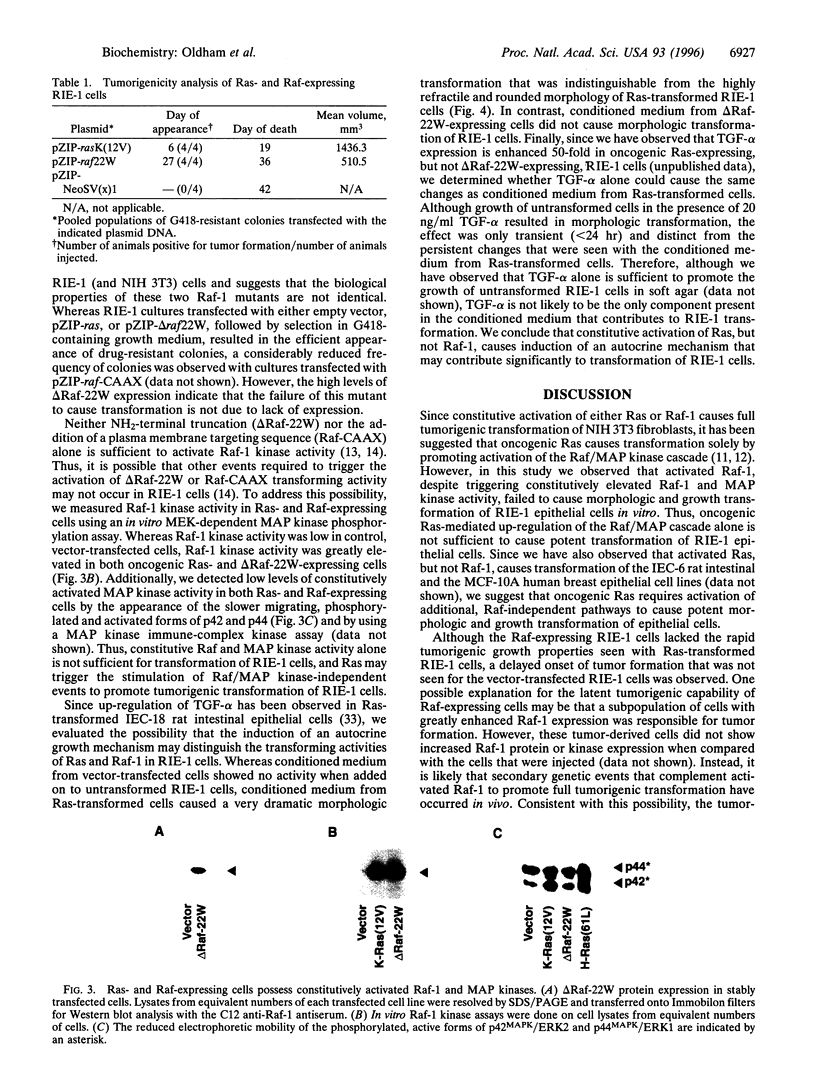
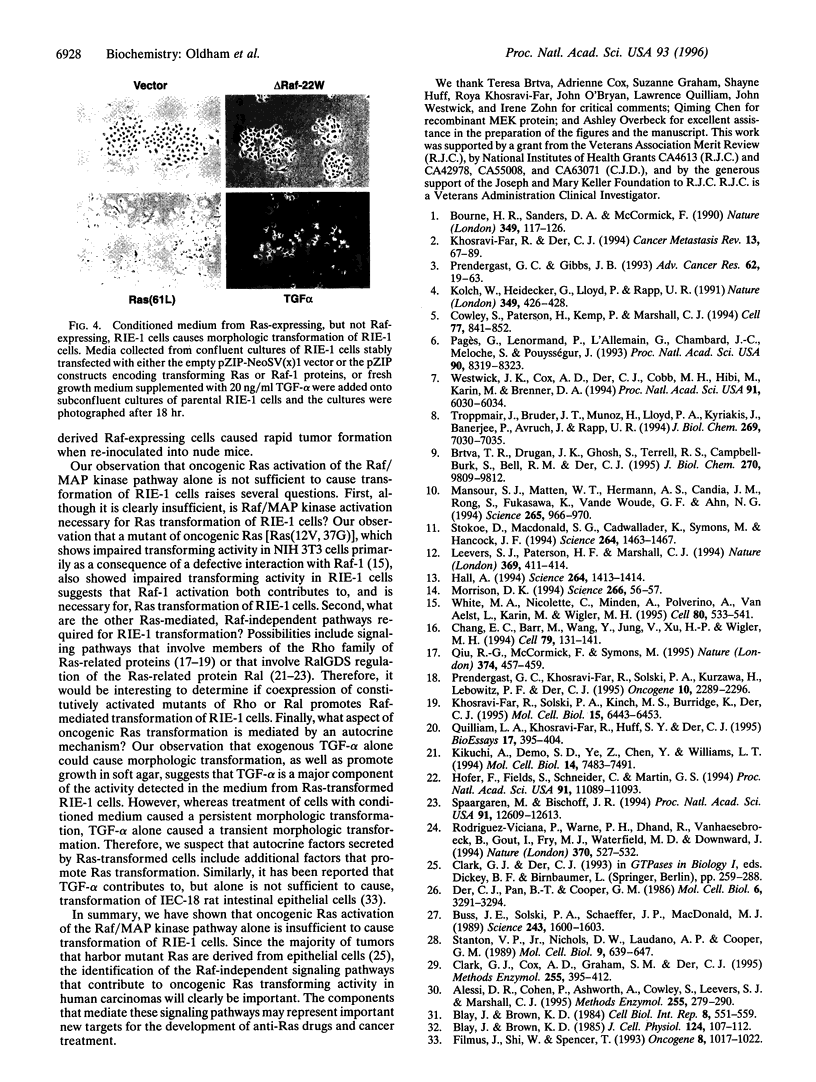
Images in this article
Selected References
These references are in PubMed. This may not be the complete list of references from this article.
- Alessi D. R., Cohen P., Ashworth A., Cowley S., Leevers S. J., Marshall C. J. Assay and expression of mitogen-activated protein kinase, MAP kinase kinase, and Raf. Methods Enzymol. 1995;255:279–290. doi: 10.1016/s0076-6879(95)55031-3. [DOI] [PubMed] [Google Scholar]
- Blay J., Brown K. D. Characterization of an epithelioid cell line derived from rat small intestine: demonstration of cytokeratin filaments. Cell Biol Int Rep. 1984 Jul;8(7):551–560. doi: 10.1016/0309-1651(84)90054-7. [DOI] [PubMed] [Google Scholar]
- Blay J., Brown K. D. Epidermal growth factor promotes the chemotactic migration of cultured rat intestinal epithelial cells. J Cell Physiol. 1985 Jul;124(1):107–112. doi: 10.1002/jcp.1041240117. [DOI] [PubMed] [Google Scholar]
- Bourne H. R., Sanders D. A., McCormick F. The GTPase superfamily: conserved structure and molecular mechanism. Nature. 1991 Jan 10;349(6305):117–127. doi: 10.1038/349117a0. [DOI] [PubMed] [Google Scholar]
- Brtva T. R., Drugan J. K., Ghosh S., Terrell R. S., Campbell-Burk S., Bell R. M., Der C. J. Two distinct Raf domains mediate interaction with Ras. J Biol Chem. 1995 Apr 28;270(17):9809–9812. doi: 10.1074/jbc.270.17.9809. [DOI] [PubMed] [Google Scholar]
- Buss J. E., Solski P. A., Schaeffer J. P., MacDonald M. J., Der C. J. Activation of the cellular proto-oncogene product p21Ras by addition of a myristylation signal. Science. 1989 Mar 24;243(4898):1600–1603. doi: 10.1126/science.2648572. [DOI] [PubMed] [Google Scholar]
- Chang E. C., Barr M., Wang Y., Jung V., Xu H. P., Wigler M. H. Cooperative interaction of S. pombe proteins required for mating and morphogenesis. Cell. 1994 Oct 7;79(1):131–141. doi: 10.1016/0092-8674(94)90406-5. [DOI] [PubMed] [Google Scholar]
- Clark G. J., Cox A. D., Graham S. M., Der C. J. Biological assays for Ras transformation. Methods Enzymol. 1995;255:395–412. doi: 10.1016/s0076-6879(95)55042-9. [DOI] [PubMed] [Google Scholar]
- Cowley S., Paterson H., Kemp P., Marshall C. J. Activation of MAP kinase kinase is necessary and sufficient for PC12 differentiation and for transformation of NIH 3T3 cells. Cell. 1994 Jun 17;77(6):841–852. doi: 10.1016/0092-8674(94)90133-3. [DOI] [PubMed] [Google Scholar]
- Der C. J., Pan B. T., Cooper G. M. rasH mutants deficient in GTP binding. Mol Cell Biol. 1986 Sep;6(9):3291–3294. doi: 10.1128/mcb.6.9.3291. [DOI] [PMC free article] [PubMed] [Google Scholar]
- Filmus J., Shi W., Spencer T. Role of transforming growth factor alpha (TGF-alpha) in the transformation of ras-transfected rat intestinal epithelial cells. Oncogene. 1993 Apr;8(4):1017–1022. [PubMed] [Google Scholar]
- Hall A. A biochemical function for ras--at last. Science. 1994 Jun 3;264(5164):1413–1414. doi: 10.1126/science.8197454. [DOI] [PubMed] [Google Scholar]
- Hofer F., Fields S., Schneider C., Martin G. S. Activated Ras interacts with the Ral guanine nucleotide dissociation stimulator. Proc Natl Acad Sci U S A. 1994 Nov 8;91(23):11089–11093. doi: 10.1073/pnas.91.23.11089. [DOI] [PMC free article] [PubMed] [Google Scholar]
- Khosravi-Far R., Der C. J. The Ras signal transduction pathway. Cancer Metastasis Rev. 1994 Mar;13(1):67–89. doi: 10.1007/BF00690419. [DOI] [PubMed] [Google Scholar]
- Khosravi-Far R., Solski P. A., Clark G. J., Kinch M. S., Der C. J. Activation of Rac1, RhoA, and mitogen-activated protein kinases is required for Ras transformation. Mol Cell Biol. 1995 Nov;15(11):6443–6453. doi: 10.1128/mcb.15.11.6443. [DOI] [PMC free article] [PubMed] [Google Scholar]
- Kikuchi A., Demo S. D., Ye Z. H., Chen Y. W., Williams L. T. ralGDS family members interact with the effector loop of ras p21. Mol Cell Biol. 1994 Nov;14(11):7483–7491. doi: 10.1128/mcb.14.11.7483. [DOI] [PMC free article] [PubMed] [Google Scholar]
- Kolch W., Heidecker G., Lloyd P., Rapp U. R. Raf-1 protein kinase is required for growth of induced NIH/3T3 cells. Nature. 1991 Jan 31;349(6308):426–428. doi: 10.1038/349426a0. [DOI] [PubMed] [Google Scholar]
- Leevers S. J., Paterson H. F., Marshall C. J. Requirement for Ras in Raf activation is overcome by targeting Raf to the plasma membrane. Nature. 1994 Jun 2;369(6479):411–414. doi: 10.1038/369411a0. [DOI] [PubMed] [Google Scholar]
- Mansour S. J., Matten W. T., Hermann A. S., Candia J. M., Rong S., Fukasawa K., Vande Woude G. F., Ahn N. G. Transformation of mammalian cells by constitutively active MAP kinase kinase. Science. 1994 Aug 12;265(5174):966–970. doi: 10.1126/science.8052857. [DOI] [PubMed] [Google Scholar]
- Morrison D. 14-3-3: modulators of signaling proteins? Science. 1994 Oct 7;266(5182):56–57. doi: 10.1126/science.7939645. [DOI] [PubMed] [Google Scholar]
- Pagès G., Lenormand P., L'Allemain G., Chambard J. C., Meloche S., Pouysségur J. Mitogen-activated protein kinases p42mapk and p44mapk are required for fibroblast proliferation. Proc Natl Acad Sci U S A. 1993 Sep 15;90(18):8319–8323. doi: 10.1073/pnas.90.18.8319. [DOI] [PMC free article] [PubMed] [Google Scholar]
- Prendergast G. C., Gibbs J. B. Pathways of Ras function: connections to the actin cytoskeleton. Adv Cancer Res. 1993;62:19–64. doi: 10.1016/s0065-230x(08)60314-0. [DOI] [PubMed] [Google Scholar]
- Prendergast G. C., Khosravi-Far R., Solski P. A., Kurzawa H., Lebowitz P. F., Der C. J. Critical role of Rho in cell transformation by oncogenic Ras. Oncogene. 1995 Jun 15;10(12):2289–2296. [PubMed] [Google Scholar]
- Qiu R. G., Chen J., Kirn D., McCormick F., Symons M. An essential role for Rac in Ras transformation. Nature. 1995 Mar 30;374(6521):457–459. doi: 10.1038/374457a0. [DOI] [PubMed] [Google Scholar]
- Quilliam L. A., Khosravi-Far R., Huff S. Y., Der C. J. Guanine nucleotide exchange factors: activators of the Ras superfamily of proteins. Bioessays. 1995 May;17(5):395–404. doi: 10.1002/bies.950170507. [DOI] [PubMed] [Google Scholar]
- Rodriguez-Viciana P., Warne P. H., Dhand R., Vanhaesebroeck B., Gout I., Fry M. J., Waterfield M. D., Downward J. Phosphatidylinositol-3-OH kinase as a direct target of Ras. Nature. 1994 Aug 18;370(6490):527–532. doi: 10.1038/370527a0. [DOI] [PubMed] [Google Scholar]
- Spaargaren M., Bischoff J. R. Identification of the guanine nucleotide dissociation stimulator for Ral as a putative effector molecule of R-ras, H-ras, K-ras, and Rap. Proc Natl Acad Sci U S A. 1994 Dec 20;91(26):12609–12613. doi: 10.1073/pnas.91.26.12609. [DOI] [PMC free article] [PubMed] [Google Scholar]
- Stanton V. P., Jr, Nichols D. W., Laudano A. P., Cooper G. M. Definition of the human raf amino-terminal regulatory region by deletion mutagenesis. Mol Cell Biol. 1989 Feb;9(2):639–647. doi: 10.1128/mcb.9.2.639. [DOI] [PMC free article] [PubMed] [Google Scholar]
- Stokoe D., Macdonald S. G., Cadwallader K., Symons M., Hancock J. F. Activation of Raf as a result of recruitment to the plasma membrane. Science. 1994 Jun 3;264(5164):1463–1467. doi: 10.1126/science.7811320. [DOI] [PubMed] [Google Scholar]
- Troppmair J., Bruder J. T., Munoz H., Lloyd P. A., Kyriakis J., Banerjee P., Avruch J., Rapp U. R. Mitogen-activated protein kinase/extracellular signal-regulated protein kinase activation by oncogenes, serum, and 12-O-tetradecanoylphorbol-13-acetate requires Raf and is necessary for transformation. J Biol Chem. 1994 Mar 4;269(9):7030–7035. [PubMed] [Google Scholar]
- Westwick J. K., Cox A. D., Der C. J., Cobb M. H., Hibi M., Karin M., Brenner D. A. Oncogenic Ras activates c-Jun via a separate pathway from the activation of extracellular signal-regulated kinases. Proc Natl Acad Sci U S A. 1994 Jun 21;91(13):6030–6034. doi: 10.1073/pnas.91.13.6030. [DOI] [PMC free article] [PubMed] [Google Scholar]
- White M. A., Nicolette C., Minden A., Polverino A., Van Aelst L., Karin M., Wigler M. H. Multiple Ras functions can contribute to mammalian cell transformation. Cell. 1995 Feb 24;80(4):533–541. doi: 10.1016/0092-8674(95)90507-3. [DOI] [PubMed] [Google Scholar]






